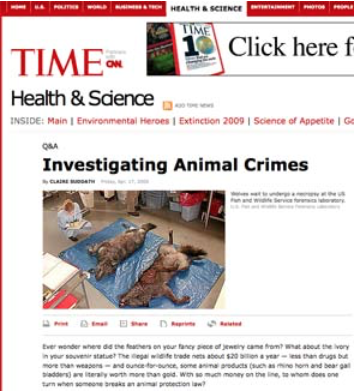TIME.com Q&A Investigating Animal Crimes
 Ever wonder where did the feathers on your fancy piece of jewelry came from? What about the ivory in your souvenir statue? The illegal wildlife trade nets about $20 million a year — less than drugs but more than weapons — and ounce-for-ounce, some animal products (such as rhino horn and bear gall bladders) are literally worth more than gold. With so much money on the line, to whom does one turn when someone breaks an animal protection law?
Ever wonder where did the feathers on your fancy piece of jewelry came from? What about the ivory in your souvenir statue? The illegal wildlife trade nets about $20 million a year — less than drugs but more than weapons — and ounce-for-ounce, some animal products (such as rhino horn and bear gall bladders) are literally worth more than gold. With so much money on the line, to whom does one turn when someone breaks an animal protection law?
Most forensics labs are busy trying to solve human crimes; they don’t have time to find out who killed a walrus. TIME talked to Dr. Laurel Neme about her book, Animal Investigators, in which she explains the difficulties of tracking the wildlife black market, and the one laboratory — U.S. Fish and Wildlife Service Forensics Lab in Ashland, Oregon — that tries to stop it. (See photos of the forensics lab mentioned in Neme’s book.)
People read articles about poachers in Africa, and they think, ‘They’re over there, but as long as I don’t buy something made out of ivory they’re not affecting me.’ And that just isn’t true, is it?
That’s exactly it. People know it’s happening, the way they know that illegal drugs are also being smuggled, but when you don’t see it you can’t recognize the impact. You can easily support [illegal wildlife trade] unknowingly. You’re on vacation, you see something and it’s a beautiful piece. It’s in a museum shop and they’re selling it, it must be legal, right? You don’t really know.
I never realized how hard it can be to catch the criminals. I just assumed that airport authorities would open a container and go, “Yep, that’s tiger.” But then you talk about bear gall bladders being ground into medicine…
And even if the animal is identifiable, it’s still hard to know what you’re looking at. Take bear for example. Do you have a hunting license? Does it apply to this specific type of bear and in the specific location where you caught it? Was it within the bag limit? Was it in season? You can’t tattoo a gall bladder and you don’t know if it’s legal or not. It’s the same with caviar. You have legal caviar, illegal caviar, illegal caviar being passed off as legal to escape detection, and legal caviar passed off as illegal to get a higher price. How do you tell what is what? It’s very complex.
